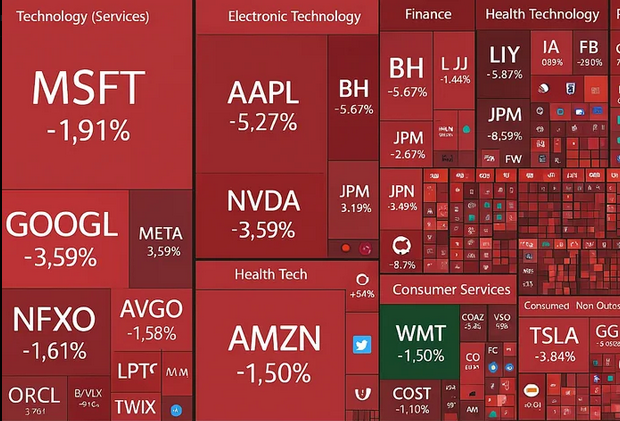April 06, 2025 – President Donald Trump's sudden 10% tariff on all imports has sent shockwaves through the global economy, reigniting trade war fears and slashing $5 trillion from the S&P 500 in mere days. Announced this week, the policy has thrown markets into turmoil, exposing vulnerabilities and raising urgent questions about immediate consequences and long-term implications.
Tariffs Land: A Bold and Divisive Strike
The tariff hammer fell on April 2, with Trump touting it as a shield for American jobs. "We're leveling the field," he proclaimed, setting a 10% baseline tariff on all trading partners, with steeper rates for major players—34% on China, 20% on the EU, and 24% on Japan. Framed as a remedy for persistent trade deficits, the move swiftly provoked a global backlash. Within 48 hours, China retaliated with matching 34% duties on U.S. exports including soybeans and electronics, while Europe and Japan signaled their own countermeasures were imminent.
Markets Stagger: A $5 Trillion Warning
The financial response was immediate and severe. By April 4, the S&P 500 had shed $5 trillion in market value, a plunge reminiscent of the 2020 pandemic crash. Early warning signs appeared in futures markets—S&P down 2%, Nasdaq 2.7%, and Bitcoin slipping 2.4%—but Friday's session delivered the full reckoning: the Dow plummeted 2.8%, London's FTSE logged its worst day since 2020, and oil prices cratered 7%.
"Trade tensions are certainly driving the initial reaction," said Maria Gonzalez, chief economist at Helix Capital, "but the scale suggests broader concerns about inflation, geopolitical stability, and an overvalued market that was primed for correction."
This dramatic market plunge represents more than fleeting panic—it signals deeper economic vulnerabilities. Supply chains, already stressed by years of disruption, now face added pressure as tariffs threaten to increase costs and stifle innovation across industries.
Shadows Lengthen: The Long-Term Cost
Beyond the immediate market reaction lie more troubling long-term implications. Sustained tariffs could fundamentally reshape global trade networks, potentially driving up inflation while constraining growth. American consumers may soon feel direct impacts through higher prices on everyday goods from smartphones to groceries, further straining household budgets in an economy still finding its post-pandemic footing.
Globally, the ripple effects spread wider: China's export-driven manufacturing sector faces potential contraction, emerging markets struggle with currency devaluations and debt pressures, and oil-producing nations reel from the sudden price drop. What began as a U.S. policy decision threatens to undermine global economic stability.
Lives Upended: The Human Face of Tariffs
The human stakes of these economic shifts reveal stark contrasts between those who see opportunity and those facing hardship.
In Ohio, steelworker Tom Henderson, 53, cautiously welcomes the news. "This could bring back the good times," he says, recalling fuller employment at his plant in decades past. For him and his colleagues, tariffs represent potential revival for their struggling industry.
Across the country in Silicon Valley, Sarah Chen, 36, a supply chain manager at a tech startup, confronts a different reality. "Every component we source from China just jumped 34% in cost," she explains, concern evident in her voice. "We're facing impossible choices between layoffs or price increases—both are painful options."
The consequences stretch internationally. In Shenzhen, China, factory owner Li Wei stands amid idle machines as U.S. orders evaporate. "We built our lives on this trade," he says, gesturing toward workers who support extended families throughout rural China. "Now it's crumbling beneath us."
At a Walmart in Des Moines, Iowa, Maria Lopez, a single mother of two, scrutinizes rising prices with growing anxiety. "Diapers, food, clothing—everything keeps climbing," she sighs. "I'm already juggling bills, and there's no more room to stretch." These personal stories illuminate how abstract economic policies translate into concrete human realities.
A Fragile Balance: Tremor or Breaking Point?
The world economy was already navigating challenges before this week's disruption. Post-pandemic recovery efforts, energy market volatility, and a strengthening dollar had created underlying stresses—Trump's tariffs may have simply ignited existing tensions. British stocks declined sharply alongside the FTSE, India's rupee weakened against major currencies, and oil-dependent economies absorbed another blow, all caught in a web of interconnected vulnerabilities.
Some analysts point to strong corporate earnings as a potential buffer against prolonged decline, but caution prevails across markets. A protracted trade standoff risks depressing investment, delaying economic recovery, and potentially pushing vulnerable economies toward recession.
What's Next: Resolution or Escalation?
The White House maintains its position, with Trump framing tariffs as strategic leverage. "They'll come to the table—watch," he insisted on April 5. Yet historical perspective offers reason for skepticism; his previous trade confrontation with China extended for years with mixed results. China's rapid and symmetrical retaliation this time suggests no simple or swift resolution.
Markets might stabilize if meaningful negotiations emerge, but the $5 trillion valuation loss reflects deeper anxiety about what may follow. "We're in uncharted territory with multiple variables at play," Gonzalez notes. "The initial market reaction may prove mild compared to the long-term structural changes these policies could trigger."
For now, the global economy balances precariously between strategic realignment and potential crisis, with businesses, investors, and ordinary citizens caught in the uncertainty.
